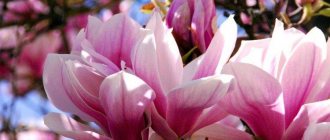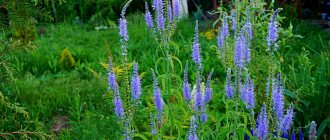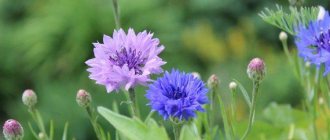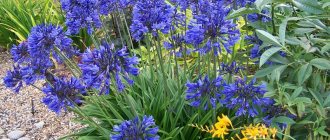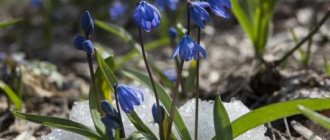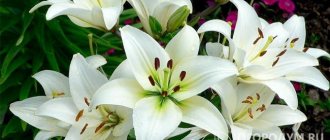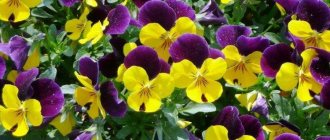Violets are not just indoor plants. There are many types of garden violets that can be grown in country houses and garden plots in the middle zone. Some types of violets are unpretentious, while others require the creation of certain conditions, and only in this case will they delight you with colorful blooms. One way or another, all types and varieties of violets are worthy of your attention, the main thing is to choose the most suitable ones for your site.
Description of the tricolor violet and its flowers (with photo)
Synonyms for tricolor violet: pansy, Ivan da Marya, tricolor, little brothers. The plant is found on forest edges, clearings, meadows among shrubs, on the outskirts of fields in the forest and forest-steppe zones of Eurasia.
Botanical characteristics: annual herbaceous plant 10-40 cm high with a thin taproot, weakly branched. The stem is simple or branched, erect, hollow. Leaves are alternate, glabrous, simple; stem ones are sessile, lower ones are petiolate. Tricolor violet flowers are single, irregular, on long peduncles.
Pay attention to the photo, the flowers of the tricolor violet are dark purple at the top and yellow at the bottom.
The fruits are elongated, ovoid, tricuspid capsules. Blooms in July - August.
Growing conditions. Unpretentious, but prefers loose, fertile soils.
Usage. Can be used to decorate forest areas and rock gardens. A popular medicinal plant in folk medicine.
Varieties. The species was introduced into cultivation a very long time ago, more than 2000 years ago, and during this time many varieties were created both directly using this species and by crossing it with other species. According to the description, the tricolor violet is most similar to the hybrids of Wittrock violet (V. x wittrockiana).
Currently, it can be difficult to determine which specific species a particular variety belongs to, since it is impossible to trace the origin of many of them, so this species is usually classified as small-flowered varieties that are similar in appearance to wild violet tricolor.
"Hortensis " - numerous, small, purple flowers with an orange eye, spreading bush.
“E.A. Bowles" ("EA Bowles"), or "Bowles Black" ("Bowles Black") - the color of the flowers is black and purple.
The violet tricolor is the official symbol of the city of Athens and Emperor Napoleon.
The beauty of the night
The garden night violet deserves special attention. The plant is a perennial. The stem is tall and straight. Its length can reach 80 cm. The upper part is branched. The leaves are pointed, slightly toothed, glabrous.
The flowers are small in size, but look magnificent due to the fact that they are collected in cylindrical brushes. The color of the petals corresponds to the palette of the slowly approaching twilight - white, lilac, purple.
This species does not require complex care and is resistant to cold weather. Night violet is often planted near benches or gazebos, because with the onset of evening the flowers bloom, filling the air with a strong and pleasant aroma.
Graceful violet in the garden
Synonyms. The violet is elegant, the violet is thin.
Distribution area. Balkans, Pyrenees, Asia Minor.
Graceful violet is a perennial plant 10-20 cm high with erect stems. The leaves are coarsely toothed. Flowers up to 4 cm, bluish-lilac or yellow. Blooms from spring to autumn.
In the garden, graceful violet is grown in sun or partial shade, on structured, well-drained, moderately moist, nutritious soils.
Usage. Used to decorate rock gardens.
Varieties of graceful violet and their photos:
"Lord Nelson" - flowers are dark purple, almost black.
"Moonlight" - yellow flowers.
" Major" - flowers are large, purple with a yellow eye.
Varieties of modest charms for a country flower garden
A great addition to any rock garden
In order for the subtle aroma of violets to delight throughout the summer, it is important to choose the most optimal variety, depending on the type of soil and region. Planting and caring for garden perennial violet does not require special skills and a lot of time, but there are still some recommendations for cultivation
Let us dwell in more detail on the most unpretentious and colorful varieties.
Graceful beauty from the Balkan mountains
In the photo is the variety “Major”
This variety is loved by gardeners for its long flowering period - from spring to late autumn. Low perennial with small purple or yellow inflorescences. Perfect for decorating rock gardens and flower beds in country style of any region.
The most popular varieties: Lord Nelson (dark purple), Moonlight (yellow), "Major" (purple flowers with a bright yellow core).
It grows well in moist, drained, well-lit areas and is responsive to regular nutritional feeding. Can be cultivated in shaded areas of the garden or in sunny open flower beds in combination with any non-aggressive plants of medium height.
Carpet of delicate fragrant flowers
"Gustave Wernig" - a lush and delicate bouquet
Imported from Italy and the highlands of southern France relatively recently, the “horned” violet has become a welcome guest in many flower beds at their summer cottage. The root system of this plant creates a colorful carpet of creeping stems with bright lilac or dark purple flowers.
A perennial plant that blooms from May to the end of September, it does not require much care and goes well with any garden design. “Horned” violet does not like too much shading.
In areas with a temperate climate and warm winters, the plant grows magnificently in sunny areas of the garden. The growing instructions recommend limiting soil moisture and organizing high-quality drainage. Due to excess moisture, the roots of the plant rot, and slugs appear in the leaves.
“White Superior” - white carpet with a subtle aroma
Interesting varieties: “Botton Blue” (blue), “Foxbrook” (cream-white), Little David (yellow), Milkmaid (cream with a bluish tint). A very beautiful variety of garden white violet “White Superior” with large white inflorescences.
Varieties for areas with cold winters
"Purpurea" - a celebration of color
Labrador violet is a small, lush plant with small inflorescences and beautifully colored bronze or purple leaves. The pinkish or scarlet color of the flower decorates the garden from the end of May and throughout June.
The plant does not require light and grows equally well in both sun and partial shade. The main distinguishing feature is resistance to frosts below 20. Loves moist, loose, fertile soil.
"Myo-Jin" - unpretentious sophistication
Manchurian violet blooms profusely from late May and throughout June. Prefers moderate humidity and is highly resistant to winter temperature changes. The plant often reproduces by self-sowing and is undemanding in care.
The most popular varieties: Mio-Jin, Fuji Don (white), Ebish (pink)
Multi-colored moth violets
"Red Giant" - a popular variety for decorating rockeries
A perennial with fluffy, heart-shaped leaves in bright, cheerful colors. Dark blue, purple, light blue, pink. It was on the basis of these varieties that the violet of the Gardens of Babylon was bred.
Stripes or specks of different shades and a greenish-cream center make the inflorescence a real work of art. Flowering most often occurs in May. Under favorable conditions, it grows into a lush, bright carpet.
The most interesting varieties: Gloriole (white), Speckles (purple with cute specks), White Ladies (white, large), Alice Witter (white with a pink center and veins).
Perennial horned violet and its photo
Distribution area. Highlands of Southern France, Spain, Italy.
Perennial horned violet has a creeping, highly branched root and numerous erect stems 15-25 cm high.
Forms cushion-shaped, dense bushes. The leaves are ovate-oblong, toothed, up to 6 cm long.
As you can see in the photo, horned violet has elongated flowers, 3-5 cm long.
Shades - from lilac to dark purple, with a small yellow “eye”. Blooms from May to September, but more abundantly in the first half of summer.
A necessary condition for growing horned violet is a dry location. This species reproduces as fragrant violet (V. odorata). Unlike Wittrock's violet (V. x wittrockiana) it does not degenerate for a long time. Prefers a sunny location, moderately fertile soil.
Usage. Horned violet is planted mainly in rock gardens, but in areas with moderately cold winters it can also be planted in flower beds - on flower beds, borders and lawns.
There are many varieties of horned violet. Among them:
" Boughton Blue" - with blue flowers.
"Foxbrook Cream" - with creamy white flowers.
Violet variety " Gazelle".
"Little David" - with yellow flowers.
Violet variety "Gustave Wernig" .
'Helen Mount' has pale blue flowers.
"Milkmaid" - cream flowers with a light blue tint.
"Molly Sanderson" - with purple-black flowers.
"Netty Britton" - with lilac-blue flowers.
"Penny Black" - flowers are almost black.
Talitha has bluish-purple flowers with a white center.
"Victoria Cowthorne" - flowers are lilac-pink.
"White Superior" - large white flowers.
“U.N. Woodgate (WN Woodgate) - flowers are light pinkish-purple-blue.
“Sorbet F1” group consists of 10 varieties with different flower colors.
The flowers of violets growing in nature are most often purple or bluish, less often white or yellow.
Unconventional color
Most gardeners strive to fill the flowerbed with plants whose flowers have bright, rich colors. Such a composition will undoubtedly attract attention, but will quickly tire the eyes. The abundance of bright colors makes the overall picture too overloaded, and then the eye desperately seeks something more restrained.
White garden violet is a plant that is not as popular as those listed above, and completely undeservedly. With the help of this beauty you can carefully and gently shade bright samples. The snow-white color will look no less interesting and will create contrast.
Such a violet can be found among representatives of different species: fragrant, horned, heeled. It is enough to choose the desired flower shape and decorate the composition with it, and it will sparkle with new colors.
Garden perennial Labrador violet
Compact, low (5-10 cm) bushes with rounded heart-shaped leaves and delicate, medium-sized flowers rising above the foliage. The color of the leaves is bronze or dark purple, especially bright in spring and early summer. The color of the flowers is pink-carmine. Flowering - late May - June.
Garden perennial Labrador violet grows well in full sun, but can tolerate partial shade. Very cold-resistant. Loves fertile, moderately moist soil.
Propagated only by seeds, which are sown in the ground in the fall or from March to May in boxes for seedlings. Seeds can germinate for quite a long time - within 1-15 months. Under favorable conditions, plants can self-sow.
Usage. In rockeries, in the foreground of mixborders, under sparse bushes, in tree trunks.
Variety "Purpurea" - dark purple flowers.
Wide choice
Gardeners must first decide how long the violet will decorate their flowerbed. After this, you can choose an annual or biennial plant. However, more and more often people choose perennial garden violets.
Their main advantage is that such plants will decorate the garden plot for many years. But for violets to feel comfortable, they need care. Then the flowerbed will acquire a delicate, but at the same time bright color. Correctly selected types of violets will help with this.
Manchurian violet in the country
A perennial herbaceous plant from 6 to 20 cm in height, with a short rhizome and ovate-lanceolate leaves on long “winged” petioles.
The flowers are dark purple, 2.5-2.6 cm in diameter, rising above the leaves on long stalks. On one plant, from 8 to 14 flowers open simultaneously.
Blooms in May - June, abundant flowering, lasts for a month.
Growing conditions. Photophilous, cold-resistant. Prefers loose, nutritious, moderately moist soils. Propagated by seeds and division of clumps. Can produce abundant self-seeding.
Usage. It can be grown in rockeries, mixborders, as well as in gardens and parks on the edges along bushes and in open places, where it forms beautiful clumps. Manchurian violets are also widely used in the country, the main thing is to provide it with regular watering.
There are many varieties with different colors and sizes of flowers, as well as with double or variegated (hatched) flowers:
" Myo-Jin" - with purple flowers.
"Fuji Dawn" - with white-variegated leaves.
"Ebiche" - with pink flowers.
Interesting on the topic:
10 remarkably beautiful annual vines that are worth...
Jan 15, 2022
I grow lush bushes of ground cover roses - gorgeous...
Jan 15, 2022
General information
Fragrant violet is a perennial herbaceous plant that grows up to 15 centimeters high and has blue-violet inflorescences. The strong creeping rhizome produces many rosettes that take root and give birth to new plants. In this way, the violet covers the ground with a beautiful green carpet strewn with small fragrant flowers. The plant lives in the Northern Hemisphere, in temperate latitudes.
Violet prefers forest edges and clearings, as well as forested mountain slopes. It is easily cultivated in gardens and parks, but if you stop caring for it, it also easily runs wild. The plant loves sunny areas or light shade, fertile and loose soils. Does not tolerate drought well. Blooms actively from April to early May, and blooms again at the end of summer. The fruit is a capsule with seeds located near the wall, ripens in June.
Phenologists note the violet’s ability to predict rain; it is sensitive to moisture, which can damage delicate pistils and stamens. Hiding them, the plant folds the petals of the inflorescences and droops during precipitation, then recovers quite quickly.
Violets (Viola) are a large genus of the Violet family (Violaceae). Today, gardeners cannot say how many species there are in the world. According to various sources, from 500 to 700. A large number of ornamental varieties were bred based on wild plants.
Fragrant violet (Viola Odorata) is one of the oldest wild-growing species, which has become the base for many domestic beauties. Here are descriptions of some popular plants:
Konigin Charlotte. A small compact bush up to 15 centimeters high with juicy green heart-shaped leaves. It blooms with large bright purple flowers, decorating flower beds from the end of April. The sweet aroma of Konigin Charlotte attracts insects; the plant is an excellent honey plant. Violet of this variety needs fertile, loose soil and good lighting.
"Alba". The plant has a small bush measuring up to 15 centimeters in height, which contains double or single flowers of bright white color with a strong impressive aroma. The variety pleases with its flowering from May to June, forming a lush white-green carpet. Prefers to grow in partial shade on loose soils with moderate humidity. Violets are planted in flower beds, in containers, and are used to make mixborders and borders.
"Little Fairy" A bushy biennial plant up to fifteen centimeters in height, has lilac simple or double flowers and a creeping stem with which it takes roots. The fragrant violet “Little Fairy” is intended for growing in open ground; it is used to create flower beds and borders. It blooms in May for three to four weeks, emitting a strong aroma.
"Tsar". Perennial bush up to 15 centimeters high with creeping rooting stems. They have purple simple or double flowers up to 3 centimeters in diameter. Has an active aroma. The plant is used to decorate balconies, rocky hills, flower beds and borders. Prefers well-drained, nutritious, moist soil in sunny or semi-shaded flowerbeds. Blooms in May for 25 days.
Moth violet and its photo
Synonyms. Sister violet, sororia violet (V. sororia).
A perennial plant 15-20 cm high. The leaves are heart-shaped or kidney-shaped, crenate, on long petioles, pubescent.
As can be seen in the photo, violet of this species has relatively large flowers with dark blue, purple, blue, and pink petals.
There are varieties with white petals with purple stripes or specks. The center of the flower is usually greenish-cream or white. The spur is creamy white. Blooms in May.
Growing conditions. A bright or slightly shaded place, nutritious, moderately moist, well-drained, loose soil.
Usage. Rockeries, rock gardens. Can be very weedy.
Varieties of violet moth:
"Gloriole" - white flowers with a blue eye.
"Red Giant " - pinkish, large flowers.
"Speckles " - purple petals with white speckles.
"White Ladies" - the flowers are large, pure white.
"Freckles " - white flowers with purple speckles.
"Alice Witter" - the flowers are pure white with a pink center and veins.
Heroine of legends
Garden tricolor violet breaks all records of popularity. Even those who have nothing to do with gardening have heard about it. It is popularly known under the romantic name of pansy. The bright, unique color literally catches the eye and fascinates, even if the violet grows in a secluded corner.
The stems of the plant are branched. The leaves are straight, ribbed in shape, and can be triangular, elongated or ovate. The edges are narrowed towards the base.
Such violets are recognized due to their characteristic colors. The two upper petals are most often purple or blue, while the lateral ones have a more contrasting color - white, yellow. The lower petal is shaped like a triangle and combines several colors at the same time. The yellow or white base is decorated with blue stripes.
Such violets bloom once a year, but for a long time. They tolerate wintering well.
Variegated violet in the garden
Forms a rosette of leaves up to 15 cm high, without shoots. The leaves are dense, kidney-shaped, 2.5-5 cm long, pubescent, dark green on top with silver veins, purple underneath.
Growing conditions. In nature it grows on dry slopes, steep cliffs, and dry steppes. In the garden, variegated violet requires bright, dry places with good drainage from fine crushed stone.
Use: Rockeries, alpine slides.
Varieties of variegated violets in the photo with descriptions:
"Syletta" - often sold under the name "cyclamenolifolia violet", has bright veins on the leaf blades.
Violet variety "Sylvia Hart" - with bright silvery veins on the leaves.
Exquisite blue
Blue garden violet is something of a classic. This is one of the most popular flowers used by gardeners when creating alpine slides, flower beds, and borders.
The combination of blue and purple looks especially interesting. They complement each other, creating interesting transitions and enhancing the depth of color. Blue violets can be found in almost any form, but pansies are the most commonly chosen variety. In them, the combination of dark and light petals appears in an unusual contrast, which allows you to use one flower in flower beds with a small area.
Korean garden violet (with photo)
Synonyms. Griffon-horned violet (V. grypoceras).
Korean violet is a perennial plant that forms a rosette of heart-shaped basal leaves at the beginning of the growing season, and then lodging leafy shoots with delta-shaped leaves.
Growing conditions. Loves moderately shady places, moist, nutritious soils.
Usage. In shady gardens, under the canopy of trees and shrubs.
Garden violet variety "Mars" - forms a large leaf rosette up to 20 cm high. As can be seen in the photo, this garden violet has variegated leaves with dark purple rays diverging from the midrib. The flowers are lilac-colored, fragrant, and are found mainly under the foliage.
general information
Garden violet is a herbaceous plant often used to decorate flower beds and other ornamental plantings.
Belongs to the genus of subshrubs. Violet can bloom at almost any time of the year. The height of the bush, depending on the type, can range from 15 to 40 cm. Its shape can be semi-spreading or compact. The size of leaves and flowers also depends on the characteristics of the species. They can be large or small, with pointed ends or wide.
Growing fragrant violets and photos of flowers
Synonyms. The violet is fragrant.
The distribution area of fragrant violet is the broad-leaved forests of Western Europe, Crimea, the Caucasus, the Balkans, Asia Minor and Western Asia, and northern Africa. Everywhere in culture.
Perennial up to 15 cm high, with a short and thick underground stem and shoots that bloom in the second year.
According to its description, fragrant violet is similar to other species, but has a pronounced pleasant aroma, for which it received its name.
Pay attention to the photo, fragrant violet has leaves with long petioles, round or ovoid, with a finely toothed edge, up to 6 cm long.
Fragrant violet flowers are about 2 cm in diameter, on long thin stalks, blue, violet, purple, white, single or double. Flowering is abundant, twice a year - at the end of May and at the end of summer.
When growing fragrant violets, it is necessary to ensure moderate moisture and soil fertility. Grows well in sun and partial shade. Propagated by seeds, dividing the bush and cuttings. Young plants begin to bloom in the second year of life. In harsh winters with little snow, plants can be damaged and bloom poorly the following season. Does not tolerate drought well. Can produce abundant self-seeding.
Usage. This species can be used to decorate light and semi-shaded areas, edges near trees and shrubs, where plants form wide clumps with continuous cover.
Varieties of fragrant violets are presented below:
"Bechtles Ideal" is a large-flowered, forcing variety.
"Queen Charlotte" - flowers are lilac-blue, large, the variety is suitable for forcing.
"Coeur d'Alsace" ("Soite d"Alsace") - pink flowers.
Variety of fragrant violets "Chris"
"Alba" - white flowers.
Variety " Red Charme"
"Rubra" - red-purple flowers.
"Triumph" is a violet variety with very large flowers.
“The Tsar” (“The Czar”) - lilac flowers, very fragrant.
Varieties:
Fragrant Parma violet, or Parma violet (V. odorata var. parmensis). Cultivated in some areas of France, mainly in the south, around Nice, and also in Northern Italy, near Parma.
It differs from the main species in its large, double, very fragrant flowers. Widely used in the perfume industry, in particular to create extracts for perfumes.
Reproduction
You can do this procedure in several ways:
- Seminal. The downside is that seedlings may appear a year later.
- By cuttings. The upper part is cut diagonally, the remaining stem is placed in a peat mixture.
- Dividing the root. It is important to remove its rotten parts.
The description of the garden violet will allow beginners and experienced gardeners to decide on the color and type of plant that will only decorate their garden plot. You can safely combine different varieties to create a real extravaganza of colors right under your window.
A well-groomed flowerbed will always attract the attention of guests and serve as evidence of the skill of the hostess. And the pleasant aroma that spreads throughout the garden will make the atmosphere of the evening even warmer and more comfortable.
Garden violet ivy
Synonyms. Violet ivy; reniform violet (V. reniforme).
A perennial plant 2.55 cm high with long, thin, creeping, intertwining shoots, with numerous small rounded leaves creating a continuous wide carpet.
Above the leaves, small round flowers open on long stalks, the central part of which is painted purple, and the tips of the petals are white.
Growing conditions. The plant is thermophilic, does not tolerate frost and does not overwinter in temperate climates. Loves damp, marshy places. In the summer, the plants are taken out into the garden and placed in a cool, bright room for the winter, reducing or temporarily stopping watering and fertilizing. Propagated by dividing clumps in the spring.
Garden ivy violet is cultivated as a container ground cover or carpet plant, most often together with other tall ornamental crops. Prefers partial shade.
Variety "Blue Form" - lilac-blue flowers.
Preparing for winter
Garden hydrangea - planting and care in open ground
Annual fragrant varieties in the fall with the arrival of frost are completely removed from the flower beds. Perennials are left for the next year, and the third year they are completely removed, as they grow too much, losing their decorative effect.
In autumn, you need to remove dry parts of the plant and wilted flower stalks. Usually by this time the seed pods have already opened and scattered. No additional planting is required.
Under favorable natural conditions, spring violets will sprout on their own after winter. It will be possible to leave successful seedlings or use them for transplants.
Growing violet capillary
Synonyms. Oblique violet (V. obliqua).
A perennial plant 15 cm high. The leaves are heart-shaped or kidney-shaped, crenate, on long petioles, pubescent. The flowers are relatively large, the petals are dark blue, purple, and white. Blooms in May.
The best conditions for growing violet cape are a bright or slightly shaded place, nutritious, moderately moist, well-drained, loose soil.
Usage. Rockeries, rock gardens. Can be very weedy.
The most common varieties of garden violet are shown below:
"Alba" - white flowers.
"Bicolor" - white flowers with purple veins.
"Gloria" is a hybrid with glossy leaves and white flowers with blue strokes.
"Rubra" - purple flowers.

